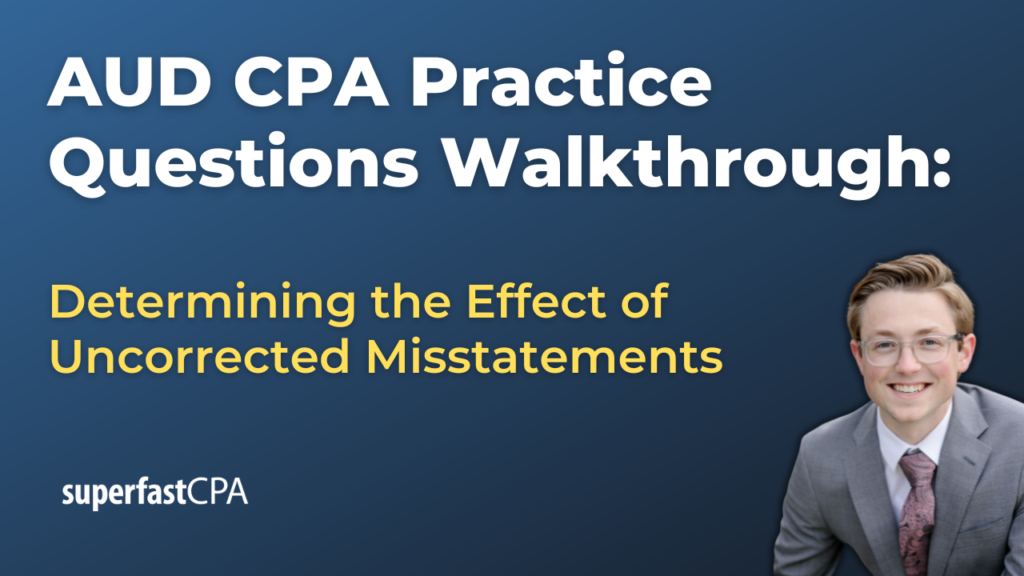In this video, we walk through 5 AUD practice questions teaching about determining the effect of uncorrected misstatements. These questions are from AUD content area 3 on the AICPA CPA exam blueprints: Performing Further Procedures and Obtaining Evidence
The best way to use this video is to pause each time we get to a new question in the video, and then make your own attempt at the question before watching us go through it.
Also be sure to watch one of our free webinars on the 6 “key ingredients” to an extremely effective & efficient CPA study process here…
Determining the Effect of Uncorrected Misstatements
During the course of an audit engagement, misstatements may be identified that management chooses not to correct. It is the auditor’s responsibility to evaluate whether these uncorrected misstatements, individually or in the aggregate, result in material misstatement of the financial statements. This evaluation requires consideration of both quantitative and qualitative factors, as well as an understanding of the specific circumstances surrounding each misstatement.
The following discussion outlines the key principles an auditor applies when determining the effect of uncorrected misstatements, including cumulative impact, prior-period considerations, and the role of internal control deviations in the overall assessment.
Materiality Is Based on Both Size and Nature
The auditor must consider both the magnitude of a misstatement (quantitative aspect) and its characteristics or circumstances (qualitative aspect). While the numerical size of a misstatement is important, a misstatement may be material due to its nature, even if it falls below the overall materiality threshold.
For example, a relatively small misstatement that affects compliance with debt covenants, involves a related party transaction, or conceals a trend in earnings could be material due to its potential influence on users of the financial statements.
Cumulative and Prior-Period Effects Must Be Considered
Uncorrected misstatements are not assessed in isolation. The auditor must consider their cumulative effect on the financial statements. Several individually immaterial misstatements may become material when considered together.
In addition, uncorrected misstatements from prior periods must be reassessed in the current period. If similar misstatements continue over multiple years, their aggregate effect may become material in the current period, even if they were not material when originally identified.
Certain Misstatements May Be Material by Nature
Certain types of misstatements may require disclosure regardless of their quantitative impact. These include:
- Omissions or misstatements involving related party transactions.
- Misstatements that affect compliance with regulatory requirements or loan covenants.
- Misstatements that result in the entity meeting or missing analyst expectations or earnings benchmarks.
For instance, the omission of a small related party transaction from the financial statement disclosures may be considered material due to its potential impact on user perception of the entity’s governance and transparency.
Deviations from Internal Controls Require Auditor Inquiry
When a deviation from a prescribed control is identified during testing, the auditor must inquire of management to understand the cause and potential consequences of the deviation. This is essential to determine whether the control is functioning as intended and whether the deviation represents a broader issue.
For example, if purchase approvals are consistently bypassed, the auditor should assess whether the deviation was due to oversight, error, or a change in procedures, and whether similar deviations could affect the financial statements.
Control Failures May Lead to Changes in Audit Approach
If a control is found not to be operating effectively—particularly if it is a manual control—the auditor may need to revise the audit strategy. This typically involves increasing the assessed level of control risk and responding by performing additional substantive procedures.
For example, if a journal entry review control is not consistently applied, the auditor may expand the scope of testing in that area and rely less on internal controls for audit evidence.
Auditors are required to exercise professional judgment and skepticism when evaluating uncorrected misstatements. Consideration of both the quantitative and qualitative implications ensures that users of the financial statements receive information that is free of material misstatement. A thorough and well-documented evaluation supports the auditor’s conclusion on whether the financial statements are presented fairly in all material respects.













